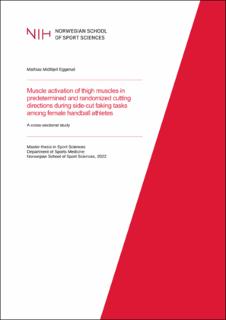| dc.description.abstract | Purpose: Muscle activity is an important factor contributing to knee joint stability during side-cut faking maneuvers. The side-cut faking maneuver is one of the most common non-contact anterior cruciate ligament (ACL) injury situations in female handball. Being a highly dynamic maneuver, the timeframe to plan an appropriate muscle activation strategy might decrease when faced with randomized events, putting the ACL at risk. However, research on muscle activation during side-cutting maneuvers has failed to recreate a realistic side-cut faking maneuver mimicking in-game scenarios. The purpose of this study was to investigate the effect of anticipation on muscle activity in female handball athletes under game-like scenarios during side-cut faking maneuvers.
Methods: Fifty-one female handball players from the Norwegian Premier, 1st, 2nd and 3rd divisions were recruited to the study. The muscle activity of biceps femoris (BF), semitendinosus (ST), vastus lateralis (VL), and vastus medialis (VM) was measured 50 milliseconds (ms) before and after initial contact (IC) by electromyography (EMG) during three side-cut faking maneuvers. For Task 1 the athletes did a side-cut in a predetermined direction. For Task 2 the athletes received a pass prior to executing a side-cut in a predetermined direction to fake a static defender. In Task 3 the athletes received a pass. When the ball was caught, two out of three defenders approached the athlete. The athlete would then be forced to cut away from the approaching defenders, resulting in a randomized cutting direction.
Results: In ST and VM there was a statistically significantly higher average muscle activation in Task 2 compared to Task 1, 50 ms before IC. In VL there was statistically significantly lower average muscle activation in Task 3 compared to Task 2, 50 ms before IC. No significant differences were detected 50 ms after IC.
Conclusion: No differences were detected between the simplest tasks with a predetermined cutting direction compared to the randomized cutting direction. The only exception was a reduced VL pre-activity between Task 2 and Task 3. Implying that the pre-activity, which is crucial to knee stability is not affected by the task complexity. Significant, yet small differences were detected within the predetermined side-cuts. Therefore, a simple task seems to be sufficient for EMG-screening when simulating ingame scenarios. There were no indications towards muscle activation patterns associated with increased ACL injury risk across tasks. | en_US |
